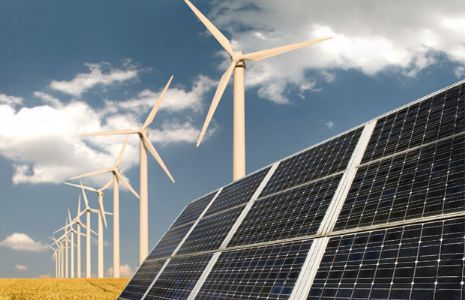The Scope and Need of Renewable Energy Manufacturing in India:Driving Sustainable Growth
Total Views | 74

Introduction
Renewable energy has emerged as a global solution to address the challenges of climate change and energy security.As the world transitions towards a low-carbon economy, the manufacturing sector plays a crucial role in the production of renewable energy technologies. This article aims to explorethe scope and need for renewable energy-related manufacturing in India, highlighting its significance in driving susta inable growth and meetingthe country's energyand environmentalgoals.
Scope of Renewable Energy Manufacturingin India
India's commitment to renewable energy has created a favorable environment for the growth of domest c manufacturing.The government's ambitious renewable energy targets, such as 175 GW of renewable power capacity by 2022 and 450 GW by 2030,provide a substantial market opportunity for renewableenergy equipment manufacturing.
The manufacturing sector in India has the potential to produce var ious renewable energy technologies, including solar photovoltaic (PV) modules, wind turbines, biomass equipment,and energy storage systems.With the helpof large and skilled labor force,India can establishitselfas aglobalmanufacturing hubfor renewable energytechnologies.
Needfor Renewable Energy Manufacturingin India Energy Security and Import Dependency
Renewable energy manufacturing can help reduce India's dependence on imported energy technologies.Currently,a significant portion of renewable energy equipment is imported, leading to increased costs and potent al supply chain disruptions. By developing a robust manufacturing ecosystem,India can enhance its energy security by reducing reliance on foreignimports.
JobCreationand Economic Growth
The expansion of renewable energy manufacturing in India has the potential to generate significant employment opportunities. The Council on Energy, Environment and Water (CEEW} estimates that achieving India's renewable energy targets could create more than 3 millionjobs by 2030. Thesejobs would spanacrossvarious stages ofthe manufacturingvalue chain,including production,assembly, research and development,and ancillary services. The growth of the manufacturingsector can drive economic growth,boost locaIeconomies, andcontributeto poverty reduction.
TechnologicalInnovation andSkill Development
Investing in renewable energy manufacturing fosters technological innovation and skill development. Domestic manufacturing facilitates knowledge transfer, encourages research and development, and promotes collaboration between academia, industry, and research institutions. This, in turn, enables the development of indigenous technologies and intellectual propertyrights.
By nurturinga skilled workforce,India can capitalize on the growingdemand for renewable energy technologies globally. Skilled professionals in manufacturing, engineering, and technology will play a critical role in advancing the sector and maintaining India's competitive edge.
GovernmentInitiatives and Policy Support
The Indian government has implemented several initiatives and policies to promote renewable energy manufacturing. The Makein India campaign aims to boost domestic manufacturing across sectors, including renewable energy. The government offers various incentives,tax benefits, and subsidies to encourage investment in renewable energy manufacturing plants and research and development centers.
The frequent changesin policies, regulations, and incentives create uncertaintyfor investors and developers, making it difficult to plan and execute renewable energy projects. Additionally, the bureaucratic red tape and slow approval processes further delay project implementation, leading to missed opportunities. Land acquisition issues, conflicting land use policies, and inadequate infrastructure pose barriers to project development. Furthermore, the lack of a comprehensive and integrated approach in policy-making results in fragmented efforts and insufficient coordination among various government agencies.
This fragmented approach hampers the effective deployment and integration of renewable energy technologies into the grid. Lastly,inadequate financing mechanisms and limited access to affordable capital hinder the scalabi ity of renewable energy projects, especially for smallandmedium-sizedenterprises.
The Goods and Services Tax (GST) system in India has some shortcomings that specificallyimpact the renewable energy sector. One significant drawback is the high GST rate imposed on certain components used in renewable energy projects1 such as solar panels, wind turbines, and their parts. This leads to increased project costs, mak ng renewable energy less competitive compared to conventional energy sources. Moreover, the ambiguity in the classification of renewable energy equipment and services under different GST slabs creates confusion and complicates compliance for stakeholders. Additionally,the complex GST compliance procedures and the requirement to register in multiplestates pose administrative burdens on renewable energy developers, particularly those operating across different regions. These challenges deter investment, hamper project viability, and impede the growth of the renewable energy sector in India. Streamlining the GST structure, providing appropriate tax incentives, and simplify ng compliance processes could greatly benefit the industry and accelerate the country's renewableenergy transition.
To attract foreign direct investment, the government has eased regulations, simplified approval processes, and provided financialassistance to renewable energy manufacturers. Additionally,the government's Production-Linked Incentive (PU) scheme offers incentives for manufactur ing high-efficiency solar modules and advanced battery storage systems, further bolsteringthe renewableenergy manufacturingsector.
Environmental Impact and Sustainable Development
Renewable energy manufacturing aligns with India's commitment to sustainable development and climate change mitigation. By producing clean energy technologies domestically,India can reduce carbon emissions associated with the transportation and import of renewable energy equipment. This, in turn,contributes to the country's climate goals under the ParisAgreement.
Furthermore, renewable energy manufacturing can drive the adoption of green manufacturing pract ces, promoting resource efficiency, waste management, and environmental sustainability. Emphasizing sustainable manufacturing processes and materials cancreate a positive environmentalimpact throughout thevaluechain.
Conclusion
The scope and needfor renewable energy-related manufactur ing inIndia are paramount in achieving sustainable growth, energy security, and environmental goals. By fostering a robust domestic manufacturing ecosystem, India can reduce import dependency,create jobs, foster technological innovation,and contribute to global efforts to combat climate change. The government's initiatives, policy support, and collaborative efforts between industry,academia, and research institutions are crucialin realizing the fullpotential of renewable energy manufacturing in India. With a strategic focus on sustainable development,India can emerge asa leader in renewable energy technology manufacturing andpavetheway for a cleaner andgreenerfuture.
References:
Council on Energy, Environment and Water (CEEW).(2020).Greening India's Workforce: Gearingupfor ExpansioninSolar andWind Energy. Retrieved from https://www.ceew.in/ Ministry of New and Renewable Energy (MNRE). (2021). Make in India for Solar Energy. Retrievedfrom http://mnre.gov.in/
Government ofIndia. (2021). MakeinIndia.Retrieved from http://www.makeinindia.com/
SwapnilBathe
Master in New and Renewable Energy(UK)
Bachleor in Mechanical Engineering(Pune University) IndustrialExperience of 12+years
Bharati Web
Mes, Pune







